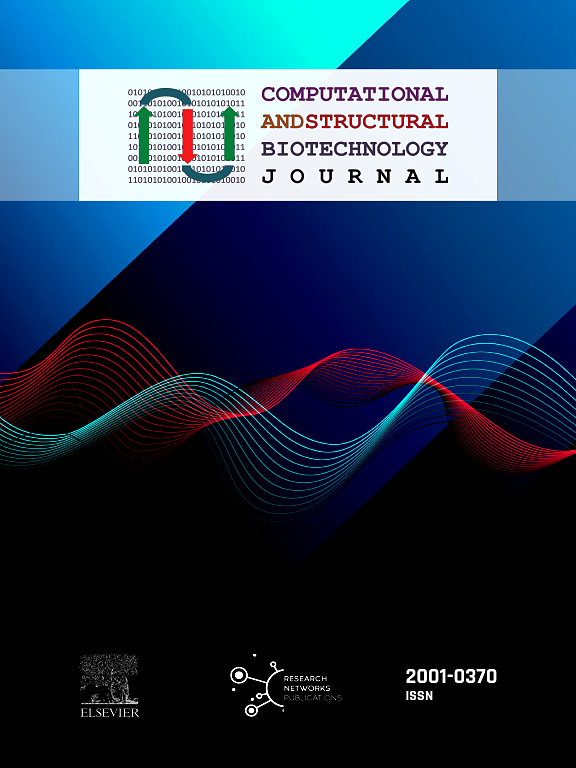BioTextQuest v2.0: An evolved tool for biomedical literature mining and concept discovery
IF 4.4
2区 生物学
Q2 BIOCHEMISTRY & MOLECULAR BIOLOGY
Computational and structural biotechnology journal
Pub Date : 2024-08-21
DOI:10.1016/j.csbj.2024.08.016
引用次数: 0
Abstract
The process of navigating through the landscape of biomedical literature and performing searches or combining them with bioinformatics analyses can be daunting, considering the exponential growth of scientific corpora and the plethora of tools designed to mine PubMed(®) and related repositories. Herein, we present BioTextQuest v2.0, a tool for biomedical literature mining. BioTextQuest v2.0 is an open-source online web portal for document clustering based on sets of selected biomedical terms, offering efficient management of information derived from PubMed abstracts. Employing established machine learning algorithms, the tool facilitates document clustering while allowing users to customize the analysis by selecting terms of interest. BioTextQuest v2.0 streamlines the process of uncovering valuable insights from biomedical research articles, serving as an agent that connects the identification of key terms like genes/proteins, diseases, chemicals, Gene Ontology (GO) terms, functions, and others through named entity recognition, and their application in biological research. Instead of manually sifting through articles, researchers can enter their PubMed-like query and receive extracted information in two user-friendly formats, tables and word clouds, simplifying the comprehension of key findings. The latest update of BioTextQuest leverages the EXTRACT named entity recognition tagger, enhancing its ability to pinpoint various biological entities within text. BioTextQuest v2.0 acts as a research assistant, significantly reducing the time and effort required for researchers to identify and present relevant information from the biomedical literature.BioTextQuest v2.0:生物医学文献挖掘和概念发现的进化工具
考虑到科学语料库的指数级增长以及为挖掘PubMed(®)和相关资料库而设计的大量工具,浏览生物医学文献、执行检索或将其与生物信息学分析相结合的过程可能令人生畏。在此,我们介绍一款生物医学文献挖掘工具 BioTextQuest v2.0。BioTextQuest v2.0是一个开源在线门户网站,用于根据选定的生物医学术语集进行文献聚类,对从PubMed摘要中获取的信息进行有效管理。该工具采用成熟的机器学习算法,便于进行文档聚类,同时允许用户通过选择感兴趣的术语来定制分析。BioTextQuest v2.0 简化了从生物医学研究文章中发掘有价值见解的过程,通过命名实体识别将基因/蛋白质、疾病、化学物质、基因本体(GO)术语、功能等关键术语的识别与它们在生物研究中的应用联系起来。研究人员无需手动筛选文章,只需输入类似于 PubMed 的查询,就能以表格和词云两种用户友好的格式获得提取的信息,从而简化了对关键发现的理解。最新更新的 BioTextQuest 利用 EXTRACT 命名实体识别标记,增强了在文本中精确定位各种生物实体的能力。BioTextQuest v2.0 就像一个研究助手,大大减少了研究人员从生物医学文献中识别和呈现相关信息所需的时间和精力。
本文章由计算机程序翻译,如有差异,请以英文原文为准。
求助全文
约1分钟内获得全文
求助全文
来源期刊

Computational and structural biotechnology journal
Biochemistry, Genetics and Molecular Biology-Biophysics
CiteScore
9.30
自引率
3.30%
发文量
540
审稿时长
6 weeks
期刊介绍:
Computational and Structural Biotechnology Journal (CSBJ) is an online gold open access journal publishing research articles and reviews after full peer review. All articles are published, without barriers to access, immediately upon acceptance. The journal places a strong emphasis on functional and mechanistic understanding of how molecular components in a biological process work together through the application of computational methods. Structural data may provide such insights, but they are not a pre-requisite for publication in the journal. Specific areas of interest include, but are not limited to:
Structure and function of proteins, nucleic acids and other macromolecules
Structure and function of multi-component complexes
Protein folding, processing and degradation
Enzymology
Computational and structural studies of plant systems
Microbial Informatics
Genomics
Proteomics
Metabolomics
Algorithms and Hypothesis in Bioinformatics
Mathematical and Theoretical Biology
Computational Chemistry and Drug Discovery
Microscopy and Molecular Imaging
Nanotechnology
Systems and Synthetic Biology
 求助内容:
求助内容: 应助结果提醒方式:
应助结果提醒方式:


